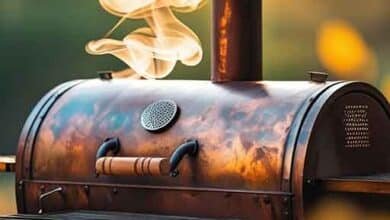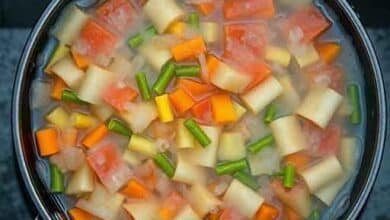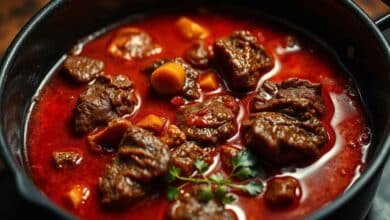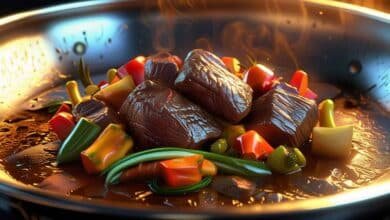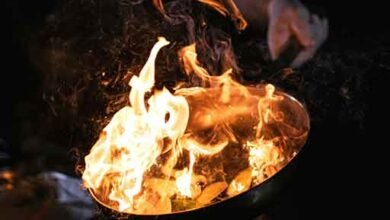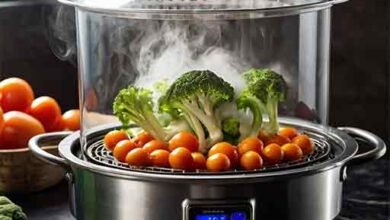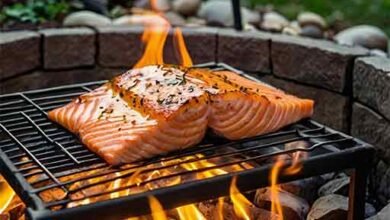Cooking Methods
There are two general types of cooking methods: dry heat cooking method and moist heat cooking method.
Dry Heat Cooking Methods
Dry heat cooking methods use air or fat. They are broiling, grilling, roasting, baking, barbecuing, smoking, sautéing, stir-frying, pan-frying and deep-frying. Foods cooked using dry heat cooking methods have a rich flavor that is caused by browning when the moisture on the surface of the food evaporates and the sugars caramelize.
Moist Heat Cooking Methods
Moist-heat cooking methods use water or steam. They are poaching, simmering,
boiling, and steaming. Moist-heat cooking methods tenderize and emphasize the natural
flavors of food.
Other cooking methods use dry and moist heat cooking methods. The two most important combination cooking methods are braising and stewing.
Combination Cooking Method
A third combination cooking method, called sous vide, resembles both braising and poaching. Each cooking method can be applied to a variety of foods including meat, fish, fruit, vegetables and even pastries. In the following material, we describe and demonstrate each of the cooking methods. Detailed procedures and recipes for applying these methods to specific foods will be found in later chapters.
-

Baking
The Ultimate Guide to Baking: From Ancient Art to Modern Science There’s a unique kind of magic that happens when you slide a pan into a warm oven. It’s in the air, a comforting aroma of melting butter, caramelizing sugar, or rising bread that fills a home and speaks a universal language of comfort and care. Baking is more than just a method of cooking; it’s a process of transformation. It turns humble ingredients—flour, sugar, eggs, and butter—into everything from crusty, rustic loaves and elaborate pastries to simple, soul-satisfying cookies.…
-

Roasting
Introduction: Beyond Baking – The Transformative Power of Roasting Fish In the culinary lexicon, the terms “baking” and “roasting” are often used interchangeably, particularly when it comes to fish. A recipe might call for “baked cod,” while another suggests “roasted salmon,” leaving the home cook to wonder if there is any meaningful difference. The distinction, while subtle, is the very foundation of culinary mastery. To view roasting not as a passive act of placing fish in an oven, but as an active, dynamic technique is to unlock a world of…
-

Smoking
Smoking is a dry heat cooking method used to flavor, color, and preserve food for immediate use. When smoking, heat is transferred to the surface of the food by convection and then into the food by conduction. Smoking involves burning wood or wood chips to produce smoke vapor, which contains compounds that help preserve and flavor the food. Smoky flavors can also be added by exposing uncooked items such as cheese and nuts to smoke without heat. Smoking preserves flavors and preserves food for longer storage. (Note that the FDA’s…
-

Boiling
Boiling is another moist-heat cooking method that uses the process of convection to transfer heat from a water-based liquid to the food. Boiling relies on a large volume of rapidly bubbling liquid to cook the food. The turbulent water and relatively high temperature cook the food more quickly than poaching or boiling. However, few foods are cooked by true boiling. Most “boiled” meats are steamed. Even “hard-boiled” eggs are simply boiled. Blanching and parboiling, also known as Mise en Place, rely on boiling water to help prepare the food to…
-

Stewing
Stewing also uses a combination of dry– and moist-heat cooking methods. Stewing is most often associated with smaller pieces of food that are first browned in a small amount of fat or oil or blanched in a liquid. Cooking is then finished in a liquid or sauce, which is served as part of the finished dish. Stewed foods have enough liquid added to cover them completely and are simmered at a constant temperature until tender. Cooking time is generally shorter for stewing than for braising because the items are smaller.…
-

Braising
Braising uses a combination of dry and moist heat cooking methods to provide the best aspects of both methods. Braising foods are usually large pieces that are first browned in a small amount of fat at a high temperature. As with sautéing, heat is transferred from the pan to the food primarily by conduction. Vegetables and seasonings are added, and enough sauce or liquid is added to cover one-third to one-half of the cooking surface. The pan is covered, and the heat is reduced. The food is then cooked over…
-

Sauteing
Sautéing is a dry-heat cooking method that uses conduction to transfer heat from a hot sauté pan to the food. The heat then enters the food through conduction. High temperatures are used for sautéing, and the food is usually cut into thin or small pieces to promote cooking. To properly sauté food, start by heating a sauté pan on the stove, then add a small amount of fat. The fat should just cover the bottom of the pan. Heat the fat to just enough to cover the bottom of the…
-

Steaming
Steaming is a moist heat cooking method that uses the process of convection to transfer heat to the food being steamed. It is often associated with tender, delicately flavored foods, such as fish and vegetables, that do not require long cooking times. Steaming food can enhance the natural flavor of food and help retain its nutrients. Properly steamed foods should be moist and tender. Additional flavor can be introduced by adding stock, aromatics, spices, or herbs to the liquid used as the steaming medium. The steaming liquid can also make…
-

Fire Pit Cooking
What is a fire pit cooking? Fire pit cooking is a dry heat cooking method In the most basic sense, a fire pit is just that “A Pit of Fire“. What started as a simple hole in the ground, in which burning wood supplied heat for warmth and cooking, has become more practical and safe over the centuries through design. Many of us think of a firepit as simply a vessel that burns wood, over which a suspended grill or hotplate can be fitted to cook food. The most basic…
-

Deep Frying
Deep frying is a dry heat cooking method that uses conduction and convection to transfer heat to food immersed in hot fat. Although conceptually similar to boiling, deep frying is not a moist heat cooking method because the fat used does not contain water. A key difference between boiling and deep frying is the temperature of the cooking medium. The boiling point, 212 °F (100 °C), is the hottest temperature at which food can be cooked in water. At this temperature, most foods require a longer cooking time and surface…


